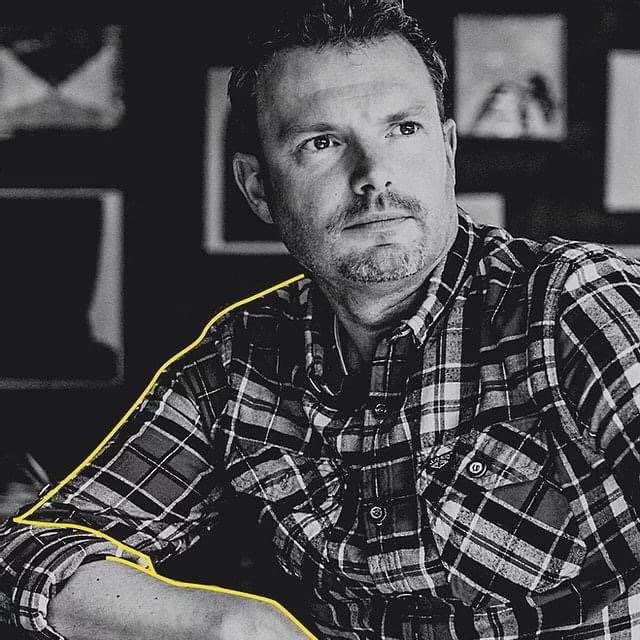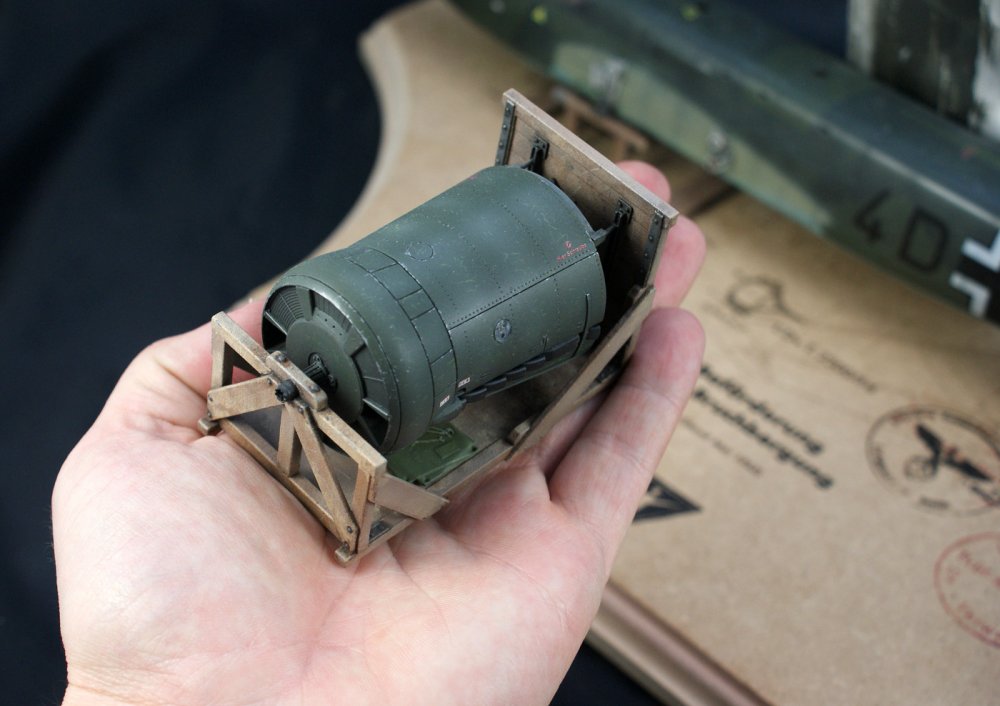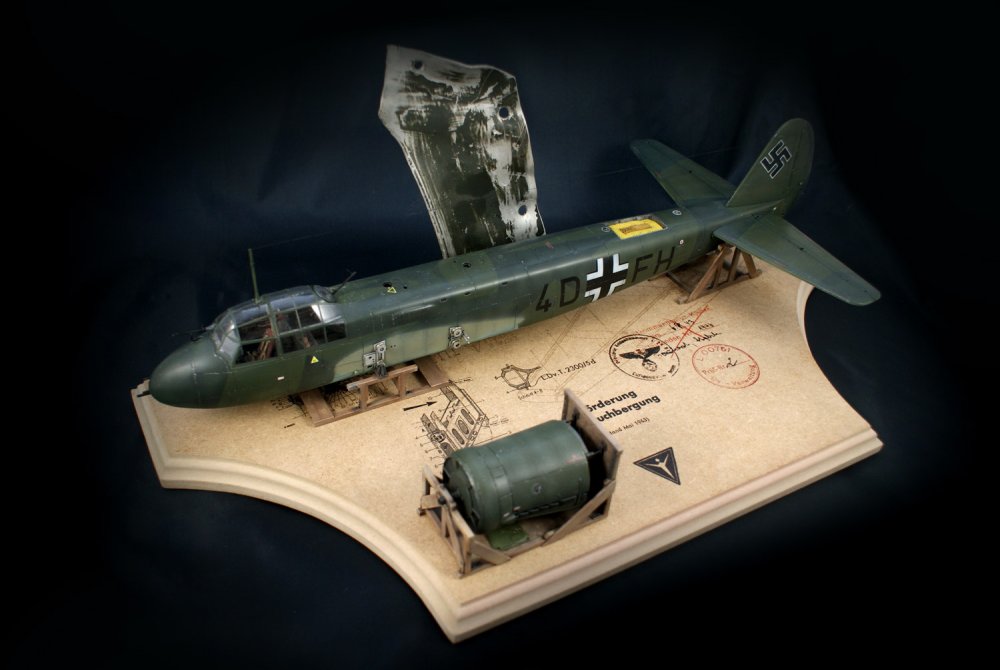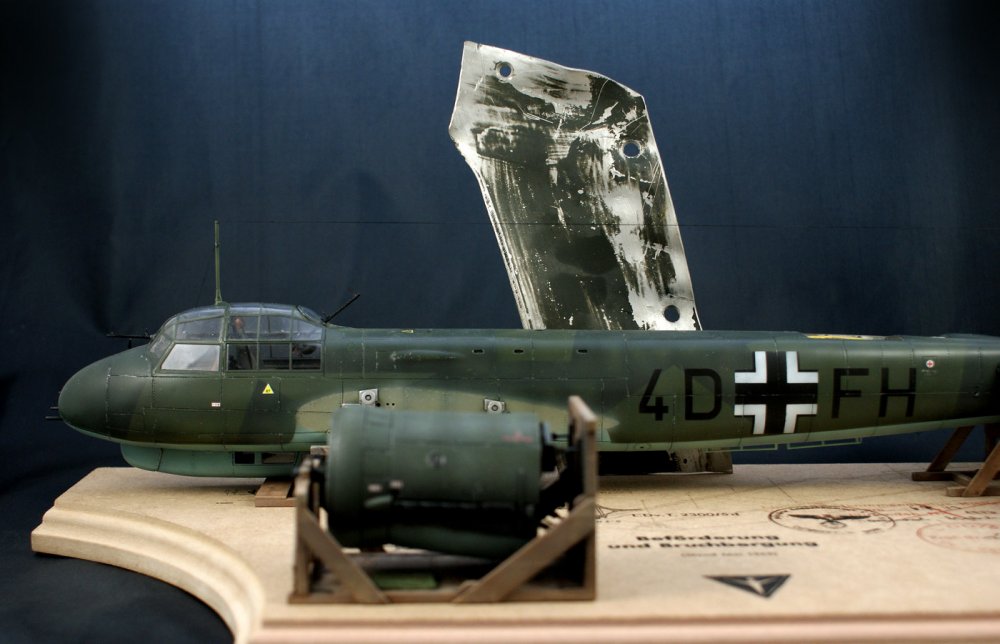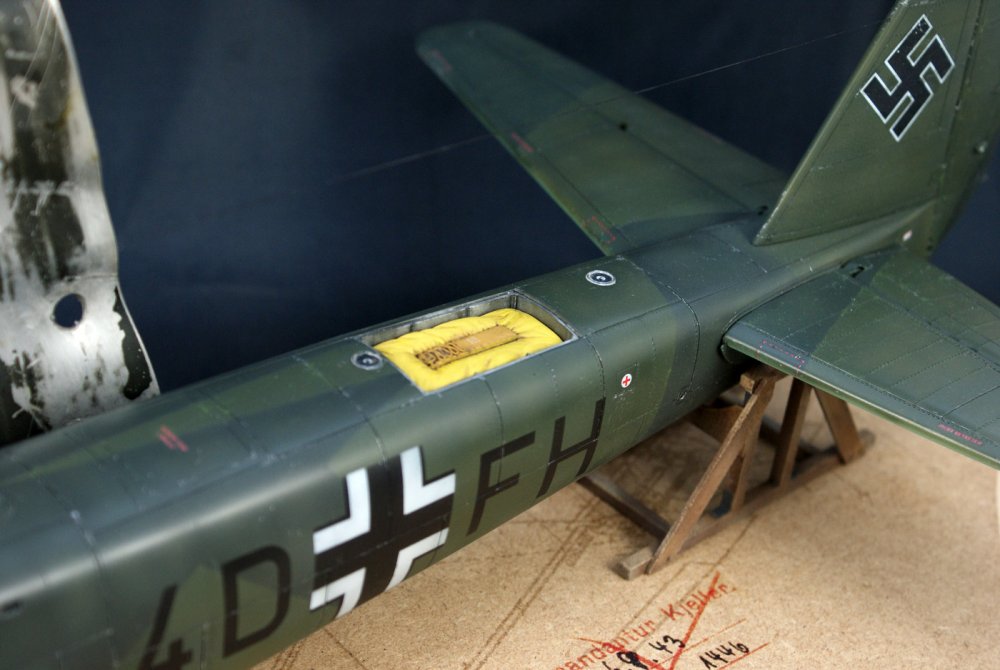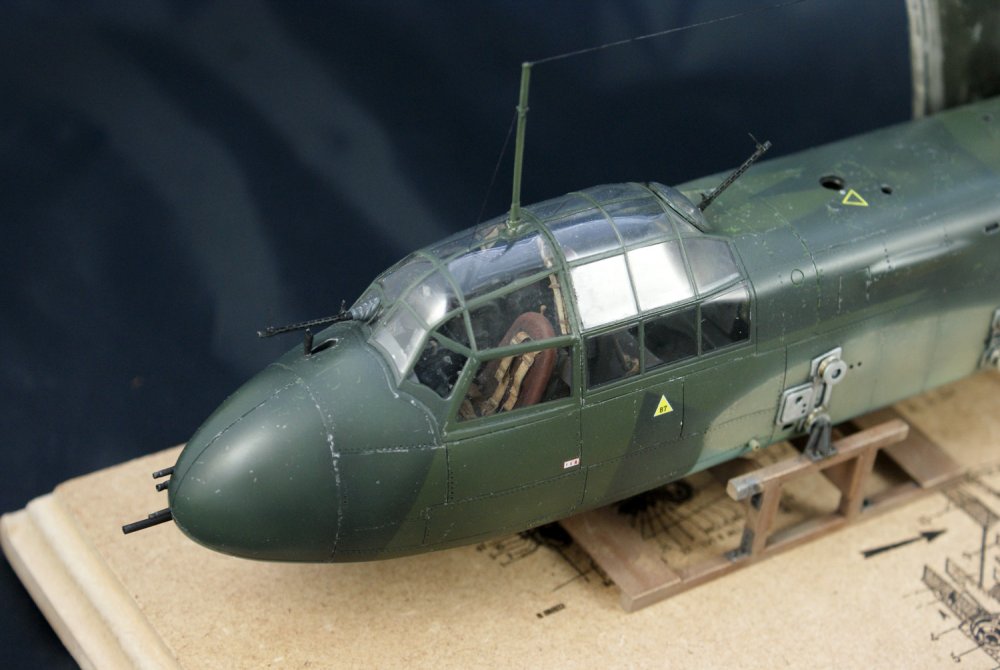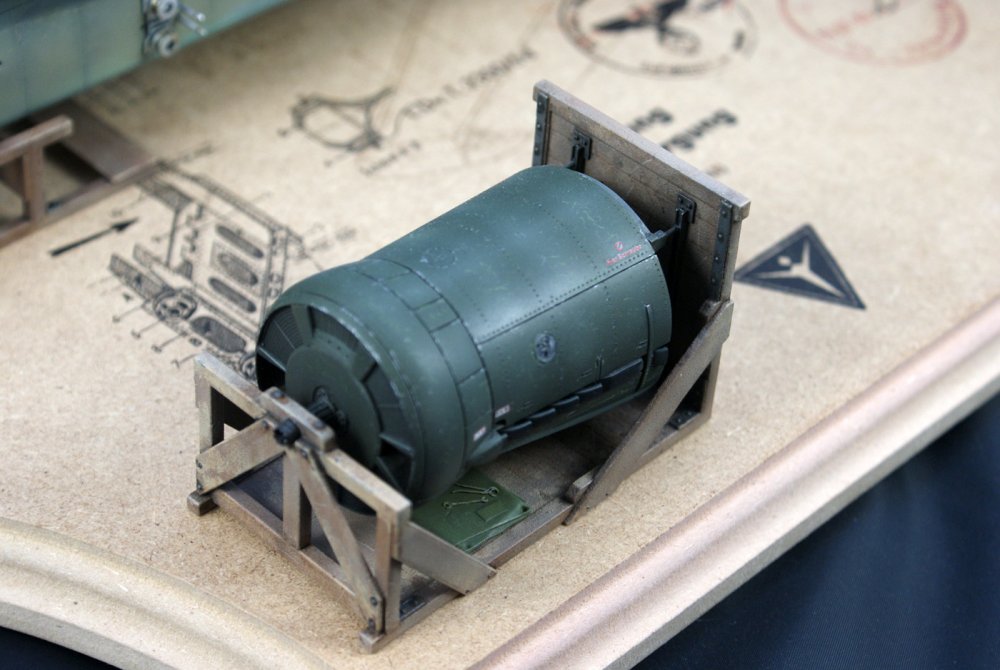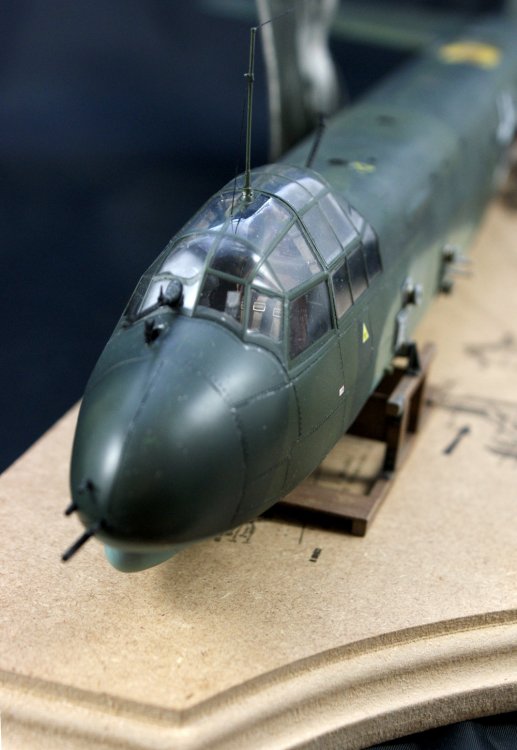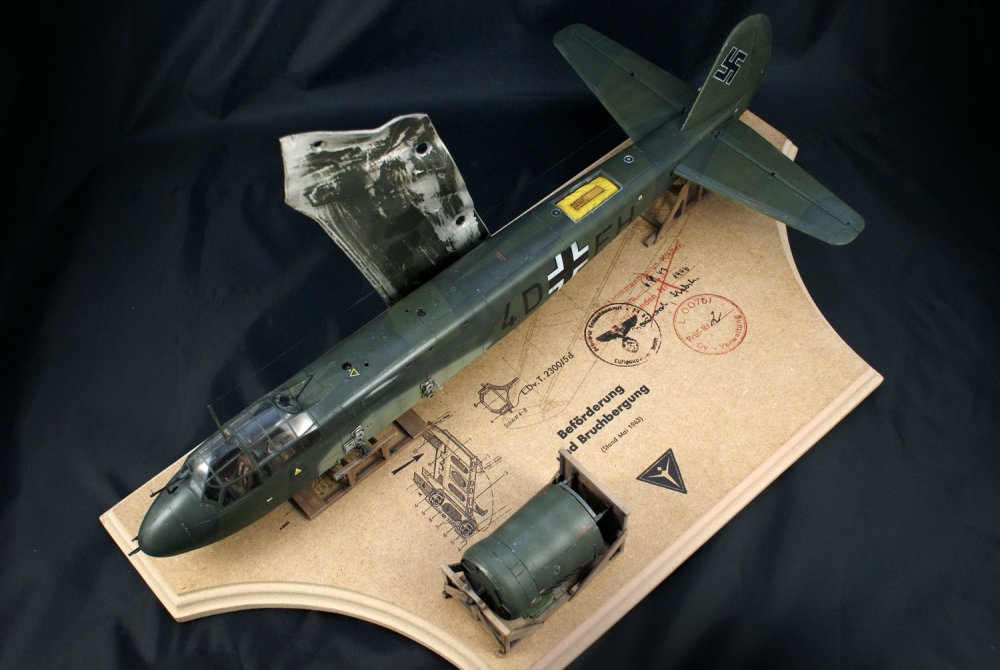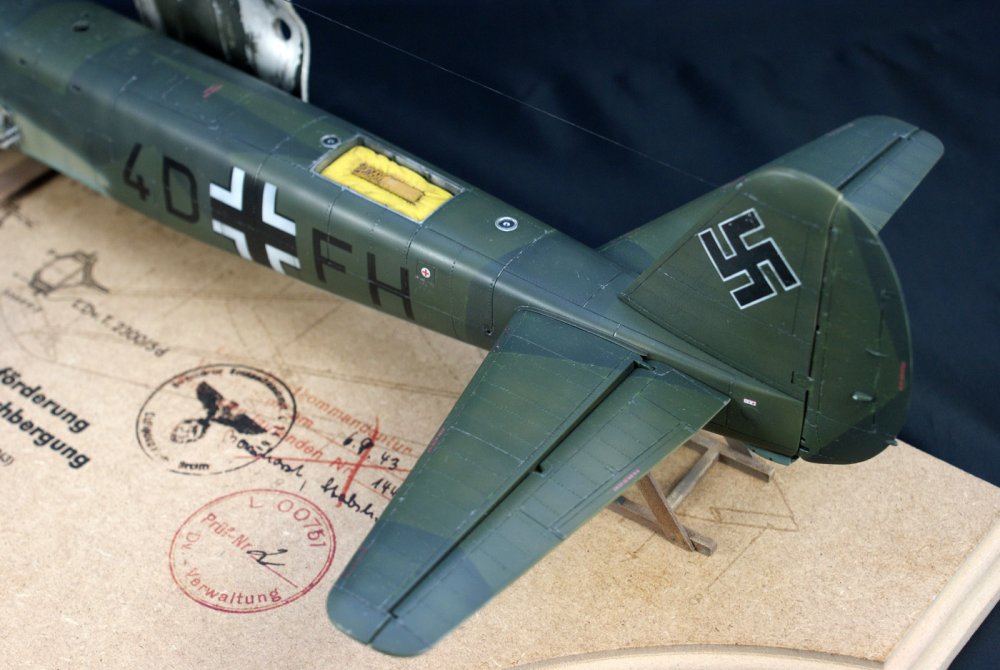-
Posts
4,779 -
Joined
-
Last visited
Content Type
Profiles
Forums
Events
Gallery
Everything posted by JeroenPeters
-
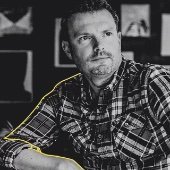
1/32 P51 Mustang Double Trouble Two
JeroenPeters replied to Corsair Experten's topic in LSM 1/35 and Larger Work In Progress
And it's good to have you here! -
After months of resisting distractions I'm finally calling this one done! What I used: • Revell Ju-88A1 kit • A part of the original 4D+FH window frame generously donated to me by James Hatch. Cheers bud! • CMK C-version conversion • AIMS interior gun arrangement • Quickboost ammo drums • CMK Radio set • CMK fuel filler and life raft set • HGW Seatbelts • Maketar Paint masks • Master gun barrels • 3D designed and printed cradles • Verlinden tarp and tools • Custom printed wooden base • I scratch built the wing root detail. I used the excellent Mr. Paint range for the camo and AK Interactive panel line washes and weathering agents. Build log here: http://forum.largescalemodeller.com/topic/3882-ju-88c-2-4dfh-in-pieces/page-1 More pics later on... Hope you like here!
- 26 replies
-
- 17
-

-

1/32 P51 Mustang Double Trouble Two
JeroenPeters replied to Corsair Experten's topic in LSM 1/35 and Larger Work In Progress
Love it! I can see the envious look from the F1 Rothmans car in the parts bin... -

Aeronaut books The Blue Max Airmen - Vol 7 - Aeronaut Books
JeroenPeters replied to Fran's topic in Tools, Books & Misc.
Nice one! Some cool photo's in there. Lovely. -

Pocket Rocket
JeroenPeters replied to ophthoidoug's topic in LSM 1/32 and Larger Aircraft Ready for Inspection
Nice one! It indeed is a sweet little kit. Another set back is the lack of cockpit detail. -

Ju-88C-2 "4D+FH" in pieces
JeroenPeters replied to JeroenPeters's topic in LSM 1/35 and Larger Work In Progress
Aaaaaaalmost done! -
ACES HIGH Magazine ‘Silver Wings’ (AK 2912 Issue 7) Publisher: AK Interactive Chief editor: Daniel Zamarbide Available from AK Interactive for € 9,00 Silver Wings! That’s this edition’s topic. One of the most difficult finishes on a model. No real wiggle room for small mistakes since you can’t weather it away or obscure it like you can easier do with camo. The reason behind this topic is no doubt the new Metallic paint range by AK: Xtreme Metal. Not so long ago the only way to achieve a convincing paint finish was bare metal foil, Alclad or some obscure rub and buff agents. Today we are spoiled with easy to use, fast drying, strong adhesive and more forgiving options: like Xtreme Metal. No need to thin, just drop it in the airbrush and go. Previous Aces High titles I have reviewed are: Aces High 4: The Mediterranean Aces High 5: Vietnam Aces High 6: Battle of Britain The magazine is available from the AK Interactive website for € 9,00 euro’s. You may think that that is steep for a magazine, but only if you view this publication as such. I tend to keep these titles and grap one when covering a certain subject or trying a new technique. Every build is accompanied with step by step tutorials, that will pull you out of your comfort zone. So what do we get with this issue? A sturdy glossy cover, binding 82 quality glossy pages. A poster in the middle (as always). Restrained advertorial space, many tutorials and techniques, and well designed lay-outs. Let me walk you through it: Index: • B26 Marauder “The Flying Barracuda” (1/72 Hasegawa B-26 by Fernando del Pino) You might remember Fernando from last editions He-111 in 72nd scale. I called it the best 72nd scale He111 I had ever seen, and I will call this the best 72nd B26 I have ever seen. The fun thing is that I have seen this build somewhere on Facebook. Back then it made me wonder how the intricate riveting was achieved. And here it is. Explained in detail. The extra detailing, polishing, masking and Xtreme Metal finish is amazing. The finished model photo’s will make you guessing for it’s scale. The only reason I wouldn’t guess it’s in 32nd scale, is because… it doesn’t exist! (Yet • Mig-21 Magyar Silver Arrow (1/32 Trumpeter Mig 21 by Bera Karoly) This Hungarian builder goes to town on the venerable Trumpeter Mig 21 and finishes it in the colours of his home country. Daniel Zamarbide certainly has a good pick when it comes to superb modellers… It’s nice to see the old salt mask technique again and some quality pre-shading. Two techniques that seem to die out at the moment. The same goes for the sponge chipping technique. Bera is old school but really makes it look great. Pretty impressive and useful stuff. • P-51D “The Mighty Mustang” (1/32 Tamiya P-51D by Michael Rosiak) I’ve seen a lot of great builds from this kit. It’s almost impossible to mess it up. And this is another fine example of how it’s done… The poster (again) is from the hand of Romain Hugault. One of those ‘comic’ book artists that will make you buy his comics, even if that’s not the sort of thing you’d normally buy! The topic is a Marilyn Monroe-type pin up, crawling out (or into) the pit of a cold war jet (F-80). These posters are perfect to adorn any self respecting man-cave! And don’t worry about tearing out use ful articles: the rear contains advertisements. • F9F Panther “Blue tail fly” (1/32 Fisher Resin F9F Panther by Daniel Zamarbide) Again: I’ve see this build on Daniel’s Facebook page. Daniel is an ‘all round’ modeller that is good at building, figure painting, detail painting and weathering. This really is an EPIC build with pretty cool step by step sequences (like painting the pilot figure and instrument panel). • F-101 C Voodoo “One-Oh-Wonder” (1/48 Kitty Hawk F-101C by Jordi Lario) Jordi hasn’t been featured in the Aces High Magazine before, but kicks off his debut with a delicate build of this Voodoo. Very subtle weathering on the aluminium panels and great masking of the colourful tail. The one thing that scares the heck out of me. Pulling off that mask at the end in the fear of peeling of precious paint. • Techniques in Detail This section explains how to successfully paint fuel tanks in all scales. Interestingly this deals with using Black base or spray the Xtreme metal directly on the plastic. Verdict A very shiny edition of this quality mag! No ‘ground section’ subject this time (normally an armour or figure topic is included). Personally: when I buy an aircraft mag, I don’t want to see any armour topics, so no tears here! Another thing that is worth mentioning is that all builds are done with Xtreme Metal. This is logical, since Aces High is an AK Interactive publication, but in previous editions other brands were thrown into the mix. Something I applauded. Other than that, this is another seriously mindblowing edition. A must have when you plan on building something shiny! Another very highly recommended! A special thanks to AK Interactive for the review sample. Available here. Jeroen Peters
-

Ju-88C-2 "4D+FH" in pieces
JeroenPeters replied to JeroenPeters's topic in LSM 1/35 and Larger Work In Progress
Nice! Taken in Berlin? Could have used this sooner!! -
Topdrawings #30 (7030) Dornier Do 17z/Do 215 Publisher: Kagero Written by: Mariusz Łukasik Available here from Kagero for € 18,24 This book will make you long for an inevitable Do-17 release in 32nd scale. Trust me. Let’s hope Revell gives it the same treatment as their excellent Ju-88 and He-111 range. Size won’t be an obstacle, since the wingspan is quite equal to the Ju-88. Sales won’t be an issue, since this is a plane that saw a LOT of variations and was used in the Battle of Britain. In other scales Hobbycraft (hmmmm), Classic Airframes and recently ICM (Yes! The Do-17Z10 and Z2) released their version in 48th scale. And when you want to save on display space you could tackle the Flying Pencil in 72nd scale, as offered by Airfix (Do17z, Do17E/F), Revell (Do17Z), ICM (Do17B-4, Do17Z10), RS Models (Do17P, Do17K), Matchbox (Do17Z2), etc.. etc… Perhaps the reason the Do17 or Do215 hasn’t been done in ‘our’ scale yet is the fact that there are no survivors remaining today. Only some large pieces or relics in museums or private collections. Or is there?.... In 2010 the RAF Museum announced that they had discovered the largely intact remains of a Do17Z (Werknummer 1160) off the coast of England. Today the wreckage has been carefully lifted of the seabed and is undergoing preservation and restoration in the RAF Museum in Cosford. The remains undergoing preservation treatment in 2013: The book These Topdrawings titles are really written and published with the modeller in mind. If features drawings of all the different versions of the Do17 and Do215 in 72nd scale which not only show panel lines, but also rivets. I myself mainly use these drawings for my riveting. Apart from this also showed are cross sections of the fuselage and wings. This should appeal the 3D modellers! Throughout the book we stumble on 7 colour profiles of a Do17Z-7, Do17Z-2, Do-17Z-1 (with top, bottom, left and right profiles in Desert Scheme), Do-215B-5, Do-215B-4, Do215B-1 and Do-17Z-2. The drawings inside the book are all in 72nd scale. Each version of the plane has a small text explaining the structural differences. If you are interested in the history of the plane or it’s operational use, this is not the book for you. If you want to check whether your model is accurate in shape or if you want to detail it up and/or rivet it… this is a must have. The book is as always accompanied by three large sheets with drawings. Printed front and back. It features drawings of the Do-17 from the top, bottom, front and side profiles in all three scales (32, 48 and 72). If we look at the 32nd scale drawings, the first thing you’ll notice is the massive size of the plane. To check whether I was going grazy, I grabbed the wing sprue of a 32nd scale Ju-88 kit and placed it on top. See for yourself: the size is quite similar. I think the visual impact is caused by the long chord of the wings. Quite like the huge wings on the He-111. And like I said in the introduction: these drawings will make you hungry for a 32nd scale version of this plane. A Ju-88 wing on top of the drawings: If the drawings don’t do it for you, perhaps the recent 1/48 completion of the ICM kit by Italian builder Paolo Portuesi will! Verdict One of those ‘need to have’ titles when tackling the Do17 / Do215 subject! The prize of 18 euro’s sure won’t be a show stopper. It won’t take up a lot of space in your book case. Let’s all buy it and pray for Revell to step up their game. I remember reviewing the Ta154 book by Kagero and guess what? I now have a 32nd scale Ta154 in my stash! Highly recommended My sincere thanks to Kagero Publishing for this review sample. To purchase directly, click THIS link. Jeroen Peters
- 4 replies
-
- 3
-

-
- topdrawings
- do215
-
(and 2 more)
Tagged with:
-

'Tribute to Sheperd Paine' (1/48 B-17 Flying Fortress)
JeroenPeters replied to kkarlsen's topic in Non LSM 'WIP
Yes! The first photo i saw made me think it was Shep's work! Great stuff.. -

1/18 Spitfire Mk. XIVe - Race #80
JeroenPeters replied to airscale's topic in LSM 1/35 and Larger Work In Progress
i LOVE International Mens Day... Superb progress and experimenting! That stick looks like the real deal. -

Ohka Model-11 (Cherry Blossom) in 1/32
JeroenPeters replied to TOMc's topic in LSM 1/35 and Larger Work In Progress
Nice and grimy! just the way i love m! -

1/18 Spitfire Mk. XIVe - Race #80
JeroenPeters replied to airscale's topic in LSM 1/35 and Larger Work In Progress
You better bring this to Telford this year. I wanna push that button!! -

Revell bf 109g 6 Elias Kuhlein white 7
JeroenPeters replied to coolboxx's topic in LSM 1/35 and Larger Work In Progress
LIKE! -
Seriously cool. This is one of those exceptions I'll make to get out of my ww2 comfort zone. As soon as it hits the shelves in 32nd scale that is. Another A+ review!
-
Impressive progress. As with some other Large scale subjects you've tackled this one is unlike to be kitted anytime soon. Makes it even more special.
- 185 replies
-
- Scratchbuild
- 1/32nd scale
-
(and 1 more)
Tagged with:
-

No-brainer Spitfire I
JeroenPeters replied to Wingco57's topic in LSM 1/35 and Larger Work In Progress
But really, once you get the hang of it, it's easier and more satisfying than decals! -
Supercool! And i LOVE the base!!
-

No-brainer Spitfire I
JeroenPeters replied to Wingco57's topic in LSM 1/35 and Larger Work In Progress
Nice. Done some more research on the codes? I reckon you can order custom masks from Maketar. -

Ju-88C-2 "4D+FH" in pieces
JeroenPeters replied to JeroenPeters's topic in LSM 1/35 and Larger Work In Progress
Ongoing! -

Ohka Model-11 (Cherry Blossom) in 1/32
JeroenPeters replied to TOMc's topic in LSM 1/35 and Larger Work In Progress
Love the wood! -
Lovely!! The gun barrels look sweet. The surface structure reminds me of the Revell kit!

